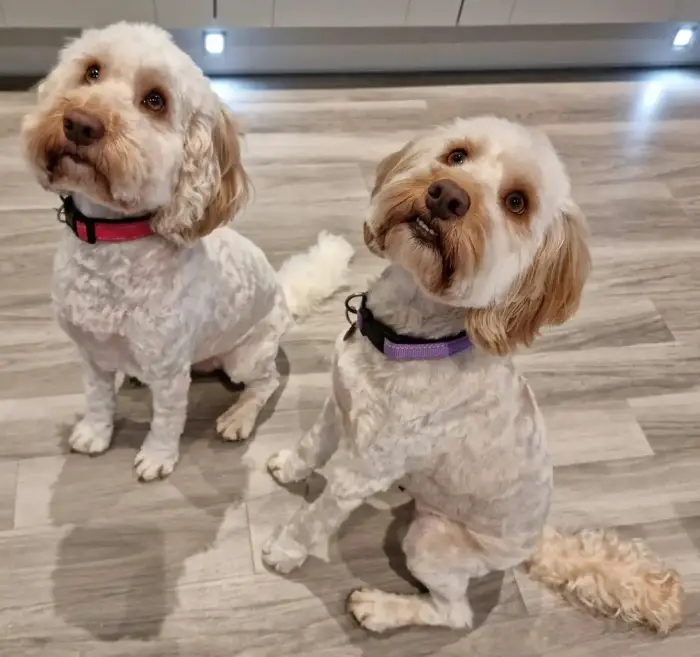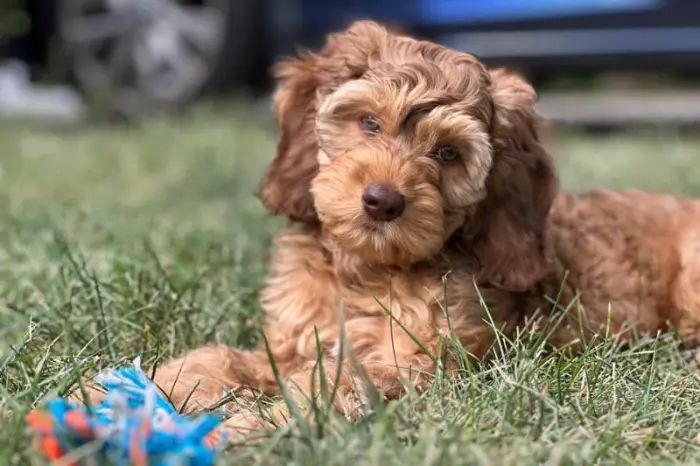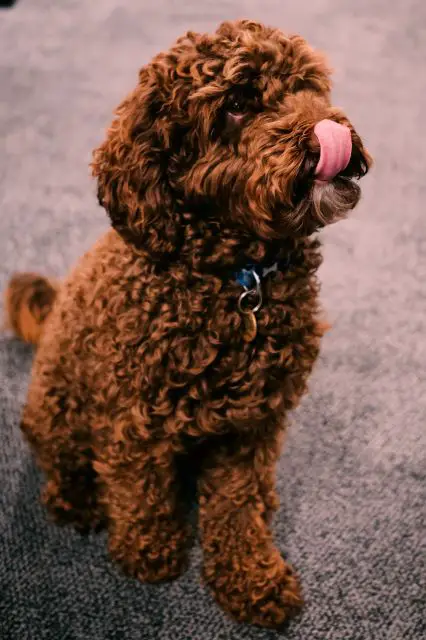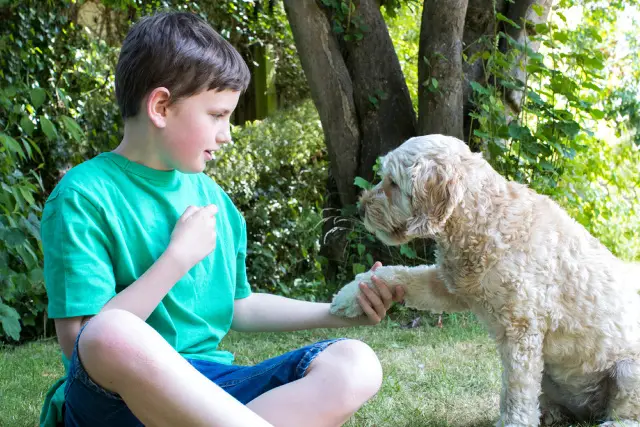If you’re wondering what all the different Cockapoo generations mean, you’re in the right place. The parent breeds, the Cocker Spaniel and Poodle, are very different in both personality and appearance. So it’s only natural to wonder if different generations and the different proportions of Poodle and Cocker Spaniel genetics present will make an impact on your Cockapoo.

By learning the differences between Cockapoo generations you can find the best Cockapoo companion for you.
F1 Cockapoos are the original hybrid between a Poodle and Cocker Spaniel. F2 Cockapoos result from breeding with two F1 Cockapoos, and F3 from two F2 parents. All of these should be 50% of each initial breed, but the F1 Cockapoos are the healthiest. F1b is backcrossed with a Poodle once, and F1bb is backcrossed twice to have more Poodle-like characteristics, including their more hypoallergenic coat.
When you’re not familiar with Poodle hybrids, this can get a little bit confusing. To make it easier to understand, here is a table illustrating the Cockapoo generations.
Table of Cockapoo Generations Simply Explained
| Cockapoo Type | Parent 1 | Parent 2 | Generation | % Poodle |
| F1 Cockapoo | Poodle | Cocker Spaniel | 1st | 50% |
| F1b Cockapoo | F1 Cockapoo | Poodle (Rarely Cocker Spaniel) | 2nd | 75% |
| F1bb Cockapoo | F1b Cockapoo | Poodle (Rarely Cocker Spaniel) | 3rd | 87.5% |
| F2 Cockapoo | F1 Cockapoo | F1 Cockapoo | 2nd | 50% |
| F3 Cockapoo | F2 Cockapoo | F2 Cockapoo | 3rd | 50% |
What is “F” and “b” in Reference to Cockapoo Generations?

The use of “F” and “b” may be intuitive after the brief explanation above. To ensure understanding, let’s look at it further.
“F” stands for filial. This is simply a genetic term meaning a hybrid generation. In this situation, it refers to the Cockapoo generation. F1 is the first generation of Cockapoo, F2 the second, and so on.
Backcrossing is represented with a “b.” Sometimes a Cockapoo may be backcrossed with a Cocker Spaniel, but in most cases, a Poodle is preferred. This is generally in an attempt to get more Poodle DNA, resulting in a coat that is closer to that of the Poodle.
So, for example, an F2bb Cockapoo occurs when a second generation Cockapoo is backcrossed twice with a Poodle. An F3b Cockapoo occurs when a third-generation Cockapoo is backcrossed once with a Poodle.
Let’s look at the different characteristics of some of these Cockapoo generations to figure out whether one would suit you more than some of the others.
F1 Cockapoo

This is the first generation of Cockapoo. It is created by breeding a Poodle and a Cocker Spaniel together. This means that each puppy would consist of 50% of each breed.
The problem with F1 Cockapoos is that you cannot predict which genes they will inherit from their parents. It is always random, and this means that it can be difficult to predict the puppies. Two F1 Cockapoos from the same litter may look and act very differently.
If you are looking for a specific coat type or want a hypoallergenic dog, you may find an F1 Cockapoo that will suit you. However, you will have to look at each puppy on an individual basis.
F1 Cockapoos have the greatest advantage in terms of hybrid vigor. This is a generic term used to describe how, when a hybrid is first created, they are far more healthy than its parent breeds. This is due to the variety of genetic material and the fact that it is almost impossible to express a recessive gene.
If you want a healthy dog and don’t mind its coat or are willing to search for the ideal one, an F1 Cockapoo is the best choice for you.
F1b Cockapoo

An F1b Cockapoo occurs when an F1 Cockapoo is backcrossed with a Poodle. These puppies will be 75% Poodle instead of 50%.
In most hybrids, the F1b generations are one of the most popular. This is no different in the Cockapoos.
The reason for this is that certain characteristics have been selected twice, making them very likely to appear. Once when breeding the F1 Cockapoo and then again when selecting a Poodle and F1 Cockapoo to create the F1b.
Additionally, they are far more likely to have a wavy or curly coat like the Poodle. They will also shed far less than an F1 Cockapoo might while still having the friendly, carefree nature of the Cocker Spaniel.
They have some hybrid vigor, but not as much as an F1 Cockapoo. Some recessive Poodle issues may start appearing again due to the high proportion of Poodle genetics.
It is important to keep in mind that these are likely to be the most expensive generation of Cockapoos because of how in demand they are. You can expect to pay as much as $2000 for these in some places.
If this does not suit your budget, you may be able to find a similar Cockapoo in an F1 generation.
F1bb Cockapoo
An F1bb Cockapoo occurs when an F1 Cockapoo is backcrossed twice. Or, when an F1b Cockapoo is bred with a Poodle yet again. This means that the F1bb Cockapoo is 87.5% Poodle. Or only 12.5% Cocker Spaniel.
These are not very easy to find because they take so much effort to breed. The F1bb Cockapoo is the most hypoallergenic option of all the Cockapoos and is likely to have a very curly coat depending on the Poodles used in backcrossing.
They still have some hybrid vigor, but the advantage is very small compared to the F1 Cockapoo.
These are very similar to Poodles, but if they have been bred with care they tend to be more friendly and less anxious due to the nature of the Cocker Spaniel.
F2 Cockapoo
An F2 Cockapoo is very similar to an F1 Cockapoo. It is created by breeding two F1 Cockapoos together, which means that it is also 50% of each initial breed.
However, F2 Cockapoos can be predicted slightly better than F1 Cockapoos because of the additional opportunity to select preferable characteristics. This means that all the puppies in the same litter are likely to be more similar.
However, it is still far less predictable than an F1b Cockapoo, so rarely bred.
Hybrid vigor still exists, but just how much is rather difficult to say. It is definitely less than there is in an F1 Cockapoo, though.
F2b Cockapoo
There are multiple ways that an F2b Cockapoo can be bred.
Some say that it is simply by backcrossing an F2 Cockapoo, resulting in a 75% Poodle hybrid. Others also allow the crossing of an F2 and F1b Cockapoo to fall into this category. This results in approximately 62.5% Poodle. For the sake of this example, we will look only at the 75% Poodle option.
The F2b Cockapoo is likely to have very similar characteristics to the F1b Cockapoo. However, these are not the preferred option of the two. This is because there is almost no hybrid vigor advantage anymore.
Usually, these do not come from professional breeders but rather from backyard breeders. Some even occur accidentally when dogs are not desexed before maturity. Lack of care in breeding can result in several health conditions, so be careful when looking at these.
Multigenerational Cockapoo

As can be seen in the F2b Cockapoo example, there are many different ways of breeding Cockapoos together. These result in an endless variety of Poodle to Cocker Spaniel genetic ratios.
It would be impossible to categorize all of these options, so they are just called Multigenerational.
To simplify things, everything from the third generation onwards, including F2b Cockapoos, is referred to as Multigenerational.
They are not bred often due to the lack of hybrid vigor and the amount of time required.
How to Get The Best Cockapoo For You?

It can be daunting to look for a Cockapoo when you know of all the different options out there. But here are some things that you can consider to help you.
First, consider whether or not you need a hypoallergenic dog. If you do, consider only the backcrossed options. F1b and F1bb is the best for you.
The same is true if you don’t want a dog that sheds.
If you are going after a specific look or personality, speak to a breeder. They spend a lot of time with the puppies before they are sold and will be willing to choose one that is the most suitable for you.
In my experience though, personality and temperament are greatly determined by how you raise your dog.
Above all, make sure that you know what you are getting before you buy it. If you are aware that your puppy is more than 80% Poodle, you will know more or less what to expect.
Further Reading:
- Cockapoo Size and Weight Guide (Teacup, Toy, Mini and Standard)
- Is A Male or Female Cockapoo Better?
- Cockapoo Temperament Guide: Cocker Spaniel Poodle Mix
- Cockapoo Coat Types and How to Care for Them
- Are Cockapoos Hypoallergenic: Do They Shed?
- 8 Cockapoo Health Problems to Know Before Buying
- Cockapoo Barking Habits: Do Cockapoos Bark a Lot?
- Cockapoo Life Expectancy: Teacup, Toy, Mini, and Standard
- Cockapoo Energy Levels: Are They High Energy?
